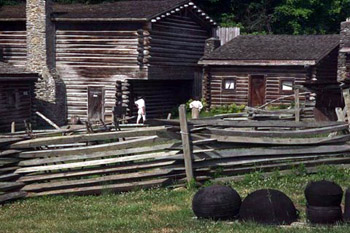
Richmond, Kentucky
by Ronald D. Kness
This story began during the French and Indian War (1753-1764), while the 19-year old Daniel Boone worked for General Edward Braddock as a teamster/blacksmith and became acquainted with a wagoner named John Findley. Instantly, Boone became intrigued with Findley’s stories of fertile valleys teaming with abundant game west of the Appalachians in a place that would eventually become Kentucky. Findley had been here before the war as part of a trading expedition with the Indians.
Four years later during the winter of 1768-1769, Findley met with Boone convincing Boone to join him on a hunting trip to Kentucky. During this trip, Boone fell in love with this new land and vowed to return someday. Four years later, Boone and five other families would make the journey and be among the first white settlers settling here.
In 1773, Boone and a group of fifty settlers having been commissioned by Colonel Richard Henderson of the Transylvania Company, left North Carolina and began making a trail west which became known as the Wilderness Road. In the years following, thousands of settlers would follow this trail in a never-ending attempt to expand the west.
In the beginning, Boone and the settlers followed a trail used for centuries by the Indians called Warrior’s Path, and then Skagg’s Trace from the Cumberland Gap into Kentucky, but the trails were too narrow for wagons to traverse and it was Boone and company’s job to widen the trails. Once at Hazel Patch, in present Laurel County, KY, Boone left the old established trails and began clearing a new one called Boone’s Trace.
Eventually the small party stopped and built a fort on the Kentucky River near present day Lexington, KY. Fort Boonesborough, became the second English-speaking settlement in this new land.
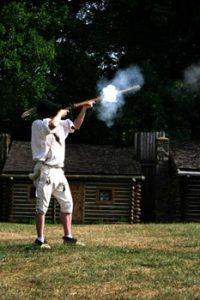 Fascinated by Boone’s story, I visited Fort Boonesborough. It is a short walk from the parking lot to the fort, but once inside, the sounds, sights and smells instantly transported me back to an earlier and much simpler time.
Fascinated by Boone’s story, I visited Fort Boonesborough. It is a short walk from the parking lot to the fort, but once inside, the sounds, sights and smells instantly transported me back to an earlier and much simpler time.
Upon entering, I hear a sharp crack, turn and in the courtyard to see the puff of smoke from a marksman’s black powder rifle. I walk around the inside perimeter of the fort. One of the first buildings I encounter is an interesting cabin – one of many inside the fort. I step inside and let my eyes adjust to the dim light. It is furnished meagerly with things the settlers used while living here – a crude four-legged table with a small slab-wood top, a mud and stick fireplace used for warmth and cooking, and a straw-filled mattress lying on the floor to sleep on. Walking further along the fence, I come to the company store. Today, visitors can buy crafts hand-made by the artisans, but back in the late 1700s, it was the only place settlers could purchase staple items such as flour, sugar and coffee after they had used up what they had brought with them. At the far end of the fort are period-clothed artisans working on their crafts. In one of the cabins, a man works leather making pouches and bags.
In another cabin, a woman weaves on a loom. In still another cabin further down, a woman works pottery using a foot-powered potter’s wheel. Across the path in the courtyard, we hear and see a blacksmith hammering red-hot iron just out of his forge.
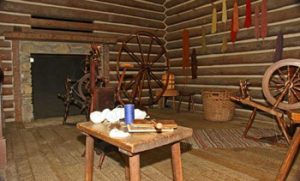 Inside, the fort reeks with authenticity. It is easy to imagine that at any moment Daniel Boone himself will step out of one of the cabins. As I walk around the fort, the one question in my mind is how did Boone come to settle this place called Boonesborough?
Inside, the fort reeks with authenticity. It is easy to imagine that at any moment Daniel Boone himself will step out of one of the cabins. As I walk around the fort, the one question in my mind is how did Boone come to settle this place called Boonesborough?
While en route to Boonesborough, Indians had relentlessly attacked the small group of settlers and over time murdered several in the party, including torturing to death Boone’s seventeen-year old son, James. After establishing the fort in September 1775, Boone went back to Clinch Valley, Virginia, where he had left his wife and the rest of his family two years earlier on the trip out, and brought them back to Boonesborough.
Fort Boonesborough became a target for Indian attacks as soon as it was built, and continuing for the next few years, as the Indians did not like the westward expansion of the white settlers. This land was their traditional tribal hunting grounds and the Indians were determined to drive the settlers out, however the settlers were determined to stay.
Boone, and those inside the fort, fended off devastating Indian raids between 1776 and 1778. During one of the raids in July 1776, Boone’s daughters, Jemima, along with two other teenage girls, were outside the fort and captured by an Indian war party.
Boone and some of his companions went after the girls. Within two days, they caught up with the Indians, ambushed and killed two of them, and rescued Jemima and the other girls. This rescue account became the basis for James Fenimore Cooper’s 1826 novel The Last of the Mohicans
.
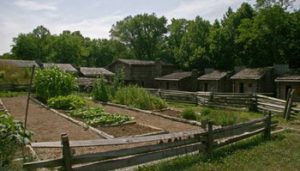 In 1777, Boone himself was captured by the Shawnee. About a year after his capture, he learned of a plan by his captors to attack Boonesborough. He escaped and made his way back to Boonesborough, covering the 160 miles in five days first by horse, until the horse gave out, and then finishing on foot, warning the residents of the upcoming attack and leading them to a successful resistance.
In 1777, Boone himself was captured by the Shawnee. About a year after his capture, he learned of a plan by his captors to attack Boonesborough. He escaped and made his way back to Boonesborough, covering the 160 miles in five days first by horse, until the horse gave out, and then finishing on foot, warning the residents of the upcoming attack and leading them to a successful resistance.
Once things settled down at Boonesborough, Boone learned his wife Rebecca, fearing he was dead, had taken the family back to North Carolina. Eventually, Boone was able to go back east, retrieve his family and all return back to Fort Boonesborough. But because of his capture, and living with the Indians, Boone never felt like he was trusted again at the fort. Eventually, this caused him to leave and settle in several different parts of Kentucky over a period of a few years.
In 1799, Boone left Kentucky because it was “getting too crowded” and he pushed farther west into the new frontier called the Louisiana Purchase, now present-day Missouri. The Spanish Government gave Boone a tract of land to encourage more settlers into the area. Boone spent the rest of his days in Missouri and died there on September 26, 1820 at the age of 86.
If you are in the area and enjoy history from this period of time, Fort Boonesborough is a must-see stop. There are other Boone historical places nearby including Boone’s Station and Boone’s Cave that add to the history of Daniel Boone and are worth exploring.
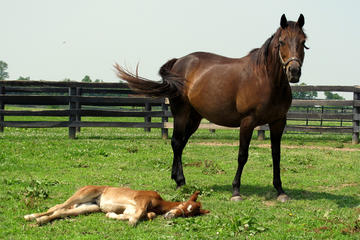
Half-Day Lexington Kentucky Horse Farm Tour
If You Go:
Kentucky State Parks website
Fort Boonesborough website
Today, Fort Boonesborough is a reconstructed working fort and a Kentucky State Park. As you tour the cabins, in many you will find costumed artisans working their crafts much like the settlers did back in the late 1700s. The fort is complete with cabins, blockhouses and furnishings. Resident artisans perform craft demonstrations and give modern-day visitors a true sense of what life was like for pioneers in Kentucky.
Admission: $7 adults, $5 children ages 6-12. Free for children under age 6. $3.00 (Admission also includes entrance to the Kentucky River Museum.) School groups of ten or more, Adult groups of ten or more $4.00. Tours are available 1 April to 31 October, 9AM – 5:30 PM. The hours of operation are 9 AM-5 PM everyday from April 1 through October 31. Phone: 859-527-3131. Location: 25 miles southeast of Lexington, KY.
About the author:
Ron Kness is a travel writer/photographer with articles and photos published in various house publications, in-flight magazines and other media sources. Ron is keenly interested in the United States history from after the Revolutionary War through the Civil War.
All photos are by Ron Kness.




[…] Read more about Daniel Boone and Fort Boonesborough. […]